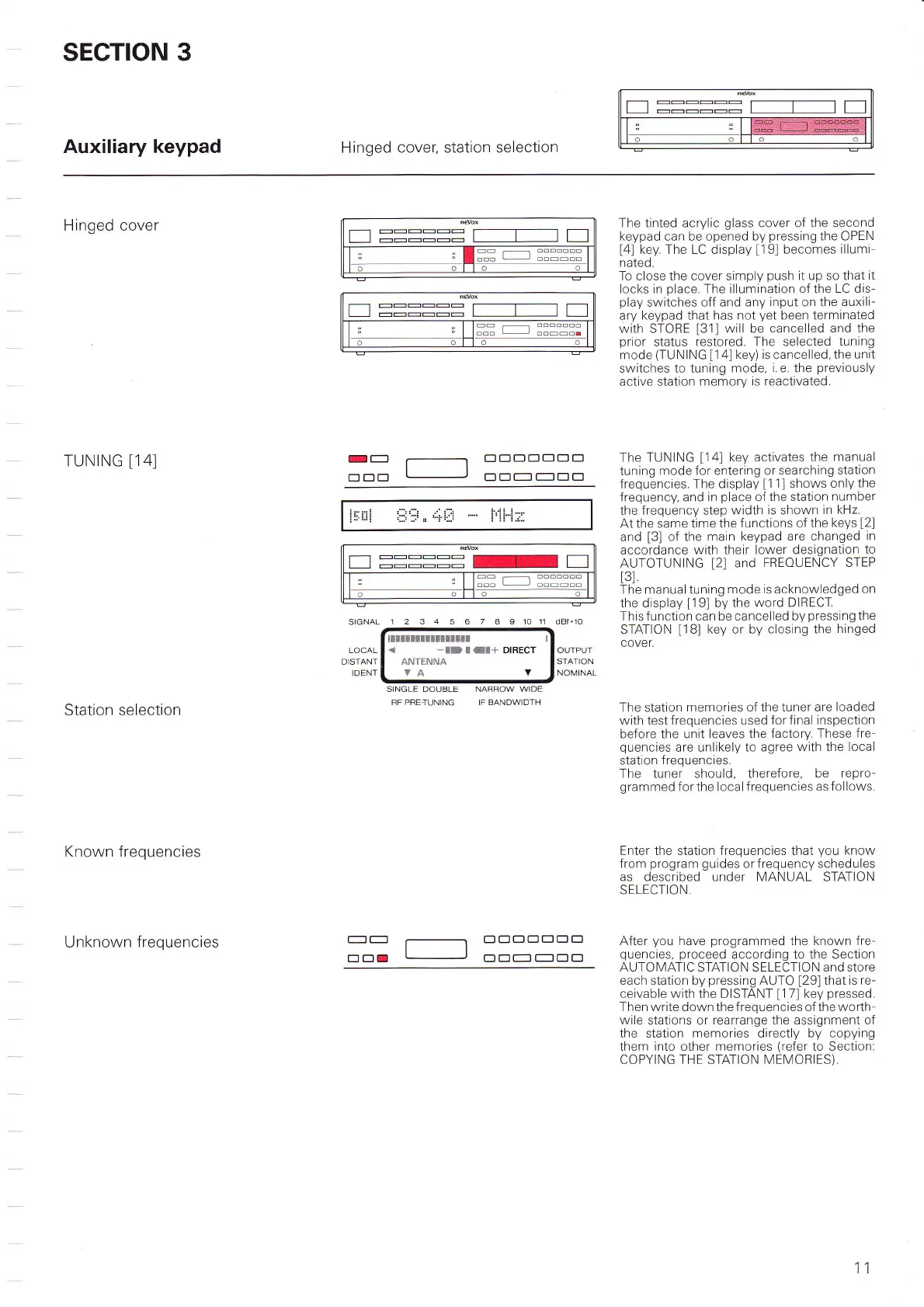sEcroN 3
Auxiliary keypad Hinged
cover. station selection
I l------l
I
ll
I
Hinged cover
TUNTNG
f14l
Station selection
Known
frequencies
Unknown
frequencies
-E--E-E--
LIE-E---l
I
lL-l
:
ll-?
r
l
=:==::
l-l
-E:Eo:
L--L------l L_j
oo
The tinted acrylic
glass
cover of the second
keypad
can be opened
by
pressing
the OPEN
[4]
key The LC display
[19]
becomes
illumi-
nated.
To close the cover simply
push
it up so that
it
locks in
place.
The illumination of the
LC dis-
play
switches off
and any input on the
auxili-
ary keypad that
has not
yet
been terminated
with
STORE
[31]
will be cancelled
and the
prior
status
restored. The selected
tuning
mode
(TUNING
[14]
key) is cancelled, the
unil
switches to
tuning mode,
i.e.
the
previously
active station
memory is reactivated.
The TUNING
[14]
key activates the
manual
tuning
mode for entering or
searching station
frequencies.
The display
[1
1]
shows
only
the
frequency, and in
place
of
the station
number
the frequency step
width
is
shown
in kHz.
At the same time the
functions of the
keys
[2]
and
[3]
of the main
keypad are changed
in
accordance
with
their
lower designation
to
AUTOTUNING
[2]
and
FREOUENCY STEP
t3l
The manualtuning
mode is acknowledged
on
the display
t19l
bv
the word DIRECT.
If---'r
-EE
OOE-OC]
r]
EEr----r
r----rElE
SIGNAL
1 10
11
dRr.1n
This function can be cancelled by
pressing
the
STATION
[18]
key
or by
closing the
hinged
cover.
OUTPUT
STATION
NOMINAL
LOCAL
DISTANT
IDENT
!6gcg&x&&gggggx&8
I
4
*8&
& &g I DTRECT
At\tT!:$1fr|Ä
YA V
SINGLE DOUBLE NARROW
WIDE
RF PRETUNING
IF BANDWIDTH
-Err
I
I
OOE-C]EE
EET_-] EEO
The station
memories
of
the tuner are
loaded
with
test
frequencies used
for final inspection
before the unit leaves the
factory. These
fre-
quencies
are unlikely
to agree
with
the
local
station frequencies.
The tuner
should,
therefore, be
repro-
grammed
for the local frequencies
as follows.
Enter the station frequencies that
you
know
from
program
guides
orfrequency schedules
as described under MANUAL STATION
SELECTION
After
you
have
programmed
the known fre-
quencies. proceed
according to the Section
AUTOIVATIC STATION SELECTION and store
each station
by
pressing
AUTO
l29l
that is re-
ceivable
with
the DISTANT
[17]
key
pressed.
Then write down the frequencies of the worth-
wile
stations or
rearrange
the assignment
of
the station memories directly by copying
them into other memories
(refer
to Section:
COPYING THE STATION
MEMORIES)
tt
